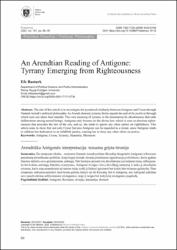| dc.contributor.author | Baştürk, Efe | |
| dc.date.accessioned | 2022-10-31T06:16:48Z | |
| dc.date.available | 2022-10-31T06:16:48Z | |
| dc.date.issued | 2022 | en_US |
| dc.identifier.citation | Basturk E. (2022). An Arendtian Reading of Antigone: Tyrrany Emerging from Righteousness. Problemos, 101, 66-78. https://doi.org/10.15388/Problemos.101.6 | en_US |
| dc.identifier.issn | 1392-1126 | |
| dc.identifier.uri | https://doi.org/10.15388/Problemos.101.6 | |
| dc.identifier.uri | https://hdl.handle.net/11436/6849 | |
| dc.description.abstract | The aim of this article is to investigate the tyrannical similarity between Antigone and Creon through Hannah Arendt's political philosophy. As Arendt claimed, tyranny firstly signals the end of the political through which men can share their natality. The very meaning of tyranny is the domination by absoluteness that ends deliberation among mortal beings. Antigone only focuses on the divine law, which is seen as absolute righteousness that precedes the law of the city, and so, she tends to ignore any other option on rightfulness. This article aims to show that not only Creon but also Antigone can be regarded as a tyrant, since Antigone tends to sublime her dedication to an infallible justice, causing her to deny any other claim on justice. | en_US |
| dc.language.iso | eng | en_US |
| dc.publisher | Vilnius University | en_US |
| dc.rights | info:eu-repo/semantics/openAccess | en_US |
| dc.subject | AntigoneCreon | en_US |
| dc.subject | Tyranny | en_US |
| dc.subject | Hamartia | en_US |
| dc.subject | Phronesis | en_US |
| dc.title | An arendtian reading of antigone: Tyrrany emerging from righteousness | en_US |
| dc.type | article | en_US |
| dc.contributor.department | RTEÜ, İktisadi ve İdari Bilimler Fakültesi, Siyaset Bilimi ve Kamu Yönetimi Bölümü | en_US |
| dc.contributor.institutionauthor | Baştürk, Efe | |
| dc.identifier.doi | 10.15388/Problemos.101.6 | en_US |
| dc.identifier.volume | 101 | en_US |
| dc.identifier.startpage | 66 | en_US |
| dc.identifier.endpage | 78 | en_US |
| dc.relation.journal | Problemos | en_US |
| dc.relation.publicationcategory | Makale - Uluslararası Hakemli Dergi - Kurum Öğretim Elemanı | en_US |


















